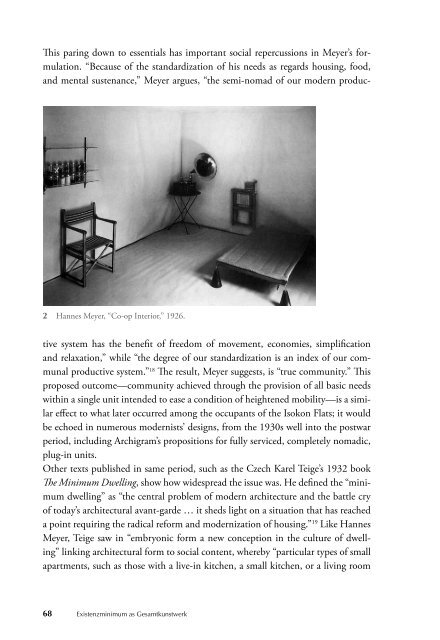The Death and Life of the Total Work of Art – Henry van de Velde and the Legacy of a Modern Concept
ISBN 978-3-86859-261-0
ISBN 978-3-86859-261-0
Create successful ePaper yourself
Turn your PDF publications into a flip-book with our unique Google optimized e-Paper software.
2 Hannes Meyer, “Co-op Interior,” 1926.<br />
This paring down to essentials has important social repercussions in Meyer’s formulation.<br />
“Because <strong>of</strong> <strong>the</strong> st<strong>and</strong>ardization <strong>of</strong> his needs as regards housing, food,<br />
<strong>and</strong> mental sustenance,” Meyer argues, “<strong>the</strong> semi-nomad <strong>of</strong> our mo<strong>de</strong>rn productive<br />
system has <strong>the</strong> benefit <strong>of</strong> freedom <strong>of</strong> movement, economies, simplification<br />
<strong>and</strong> relaxation,” while “<strong>the</strong> <strong>de</strong>gree <strong>of</strong> our st<strong>and</strong>ardization is an in<strong>de</strong>x <strong>of</strong> our communal<br />
productive system.” 18 <strong>The</strong> result, Meyer suggests, is “true community.” This<br />
proposed outcome—community achieved through <strong>the</strong> provision <strong>of</strong> all basic needs<br />
within a single unit inten<strong>de</strong>d to ease a condition <strong>of</strong> heightened mobility—is a similar<br />
effect to what later occurred among <strong>the</strong> occupants <strong>of</strong> <strong>the</strong> Isokon Flats; it would<br />
be echoed in numerous mo<strong>de</strong>rnists’ <strong>de</strong>signs, from <strong>the</strong> 1930s well into <strong>the</strong> postwar<br />
period, including Archigram’s propositions for fully serviced, completely nomadic,<br />
plug-in units.<br />
O<strong>the</strong>r texts published in same period, such as <strong>the</strong> Czech Karel Teige’s 1932 book<br />
<strong>The</strong> Minimum Dwelling, show how wi<strong>de</strong>spread <strong>the</strong> issue was. He <strong>de</strong>fined <strong>the</strong> “minimum<br />
dwelling” as “<strong>the</strong> central problem <strong>of</strong> mo<strong>de</strong>rn architecture <strong>and</strong> <strong>the</strong> battle cry<br />
<strong>of</strong> today’s architectural a<strong>van</strong>t-gar<strong>de</strong> … it sheds light on a situation that has reached<br />
a point requiring <strong>the</strong> radical reform <strong>and</strong> mo<strong>de</strong>rnization <strong>of</strong> housing.” 19 Like Hannes<br />
Meyer, Teige saw in “embryonic form a new conception in <strong>the</strong> culture <strong>of</strong> dwelling”<br />
linking architectural form to social content, whereby “particular types <strong>of</strong> small<br />
apartments, such as those with a live-in kitchen, a small kitchen, or a living room<br />
68 Existenzminimum as Gesamtkunstwerk


















